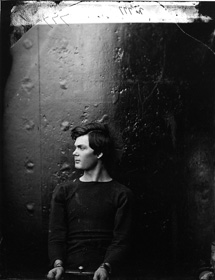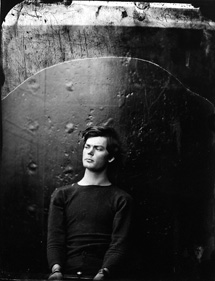Alexander Gardner
History Made, History Recorded Page 2
The Collodion Process
One of the most versatile substances discovered in the 19th century, collodion
was a thick syrupy liquid made by dissolving nitrated cotton in an alcohol/ether
mixture. Because of its strength and properties of adhesion, surgeons used it
as a liquid bandage. It wasn't until the middle of the century, though,
that English photographer Fredrick Scott Archer got the idea of using collodion
to hold light sensitive salts to glass plates. He turned out to be right and
was able to produce a photographic negative on ordinary glass plates coated
with collodion.
 In
Brady's Studio
In
Brady's Studio
Gardner specialized in making "Imperial Collodion" photographs.
These large prints (17x20") were very popular and Brady was able to sell
them for between $50 and $750, depending on the amount of retouching with India
ink that was required. As Gardner's prints continued to sell well, Brady's
eyesight deteriorated. Brady began to rely on the keen-eyed Scotsman to run
the business.
In February, 1858, Gardner was put in charge of Brady's gallery in Washington,
DC, where he quickly developed a reputation as an outstanding portrait photographer
whose printing skills could not be matched. When war broke out in 1861, Brady
sent Gardner and 18 other photographers to travel the country and make a photographic
record of the carnage. Each photographer had a traveling darkroom so that the
collodion plates could be processed on the spot.
The Conspirator Portraits
Gardner's work was widely published and he quickly developed a reputation
as Brady's artistic successor, which was why Stanton called him in to
photograph the Lincoln Conspirators. When Gardner arrived he asked to have Paine's
hood removed. What he immediately noticed was a physical beauty that belied
the true evil under Paine's handsome, rugged features and alabaster skin.
The question was how to capture it in a photograph.
In a sequence of portraits, Gardner posed his subject in a tight-fitting dark
sweater. From one exposure to another, Gardner made slight adjustments in Paine's
posture and the tilt of his head. The result is a homoerotic quality to the
Paine shots, reminiscent of Robert Mapplethorpe's sometimes disturbing
work, made even more astonishing by the primitive nature of the equipment Gardner
was using.
Lens shutters were an invention 20 years in the future. For the moment in 1865,
photographers like Gardner had to content themselves with what today would be
viewed as a primitive view camera. But coupled with his mastery of the collodion
process, his efforts produced a series of particularly life-like images.
 Gardner
Out West
Gardner
Out West
As not just a photographer but one of America's first photojournalists,
Gardner was smart enough to know when to stand back and let the event unfold.
He did that many times as the official photographer of the Union Pacific Railroad,
particularly when he photographed the signing of the Treaty of Laramie in 1868.
The event was momentous--the Sioux Nation was handing over control of the
sacred Black Hills to the US. Rather than get in close, Gardner hung back, framing
all the participants as the event unfolded. The American generals, aware of
the camera, took center stage. The photograph serves as a bitter reminder to
Native Americans of the deceit the Federal government practiced in its affairs
with the Indian nations. Gardner would go on to create great portraiture of
the Indian chiefs who visited his studio.
Despite those later triumphs, Gardner is perhaps best known for his photographs
of the actual execution of the Lincoln Conspirators--Mary Surratt, Paine,
Atzerodt, and Herold on July 7, 1865. Four months later, Gardner was asked once
again by the War Department to photograph an historic execution, that of Henry
Wirz, the commandant of Andersonville, the notorious POW camp.
Mug Shots
The knowledge he'd gained in photographing Paine and the conspirators
was put to good use when he contracted with the police force of Washington,
DC to take photographs for them of convicted criminals. They may be the oldest
mug shot files in American criminal history. And yet, it is Gardner's
photographs of Paine that linger.
That early spring night in Brooklyn, after Gardner finished photographing him,
Paine tried to commit suicide by banging his head against the Montauk's
iron plates. Somehow, in the dark hold of the ironclad Montauk, Gardner had
managed to bring out Paine's humanity, leaving us with haunting images
that have become icons of their age.
All photos reproduced from the Collections of the Library Of Congress.
Fred Rosen's book "Born to the Mob," co-authored with Frankie Saggio, is published by Thunder's Mouth Press.
How To Make A Wet Plate
1. Thoroughly clean and polish a piece of glass.
2. Hold the plate by your fingertips, in a horizontal position. Pour
collodion over the surface, allowing it to form a smooth, even coating.
3. Put the plate into a silver nitrate solution in the darkroom. Allow for a
good soaking. When removed the glass is light sensitive. While still wet,
insert into light-proof plate holder (dark slide).
4. Focus camera on subject until you are satisfied with the composition.
5. Insert plate holder into camera and remove dark slide.
6. Remove lens cap for 5 seconds to make exposure.
7. Cover lens, replace dark slide, and return to darkroom.
8. Remove plate from holder.
9. Pour an acidic iron sulfate solution over surface of glass.
Image will appear.
10. When satisfied the image has been fully developed, rinse plate in
clean water.
11. Fix the image by passing the plate over a gentle flame.
12. Handcolor if desired. Varnishing is recommended to protect the
surface for posterity.
- Log in or register to post comments

































